
The Dévastation was an Dévastation-class ironclad battleship of the French Navy of central battery (casemate) design. She was used as a school ship for manoeuvres.

Jean Bart was a protected cruiser of the Jean Bart class built for the French Navy in the late 1880s and early 1890s. The lead ship the class of two ships, Jean Bart and her sister ship were ordered during the tenure of Admiral Théophile Aube as Minister of Marine according to the theories of the Jeune École doctrine. The ships were intended as long-range commerce raiders, and they were armed with a main battery of four 164 mm (6.5 in) guns, were protected by an armor deck that was 50 to 100 mm thick, and were capable of steaming at a top speed of 19.5 knots.

Courbet was an Dévastation-class ironclad central battery battleship of the French Navy.

Amiral Duperré was an ironclad barbette ship built for the French Navy in the 1870s and 1880s; she was the first vessel of that type built by France. She carried her main battery of four 34 cm (13.4 in) guns individually in open barbette mountings, which offered increased fields of fire compared to earlier central battery ships, though they were less well protected. Amiral Duperré was ordered as part of a French naval construction program aimed at countering the growth of the Italian fleet, which had begun work on the very large ironclads of the Duilio and Italia classes in the early 1870s. The Italian vessels, armed with 45 cm (17.7 in) guns, prompted public outcry in France that pressured the navy to develop larger guns for its own ships. Amiral Duperré's design served as the basis for several follow-on classes, including the Bayard and Amiral Baudin classes.

Lapérouse was an unprotected cruiser, the lead ship of her class, built for the French Navy in the 1870s. The ship was intended to serve abroad in the French colonial empire, and was ordered to strengthen the fleet after the French defeat in the Franco-Prussian War. To allow the ship to cruise for long distances, she was fitted with a full ship rig to supplement her steam engine, and she carried a main battery of fifteen 138.6 mm (5.46 in) guns. Her top speed under steam was 15 knots.

Amiral Cécille was a protected cruiser of the French Navy, named in honour of Jean-Baptiste Cécille. The third vessel of that type built in France, her design was derived from her two predecessors, Sfax and Tage. Like those vessels, Amiral Cécille was intended to be used as a commerce raider to attack merchant shipping. As such, she carried a barque sailing rig to supplement her steam engines for long voyages overseas. Amiral Cécille was armed with a main battery of eight 164 mm (6.5 in) guns and had a curved armor deck that was 56 to 102 mm thick.

Troude was a protected cruiser of the French Navy, the lead ship of the Troude class. The class was built as part of a construction program intended to provide scouts for the main battle fleet. They were based on the preceding Forbin class, the primary improvement being the addition of armor to the conning tower. Troude was built in the 1880s and was completed in late 1890. She was armed with a main battery of four 138 mm (5.4 in) guns, protected with an armor deck that was 41 mm (1.6 in) thick, and had a top speed of 20.5 knots.

Milan was a late-19th-century unprotected cruiser in the French Navy. At the time of her completion, Milan was considered by several publications to be the fastest warship in the world. The warship was the last unprotected cruiser in French naval service, and Milan's design influenced the construction of later protected cruisers.

Vauban was the lead ship of the Vauban class of ironclad barbette ships built for the French Navy in the late 1870s and 1880s. Intended for service in the French colonial empire, she was designed as a "station ironclad", smaller versions of the first-rate vessels built for the main fleet. The Vauban class was a scaled down variant of Amiral Duperré. They carried their main battery of four 240 mm (9.4 in) guns in open barbettes, two forward side-by-side and the other two aft on the nautical. Vauban was laid down in 1879 and was completed in 1885.

Tage was a protected cruiser built for the French Navy in the 1880s, the second vessel of that type built for the French fleet. The design was based on the previous cruiser, Sfax, and like that vessel, Tage was intended to be used as a commerce raider to attack merchant shipping. As such, she carried a barque sailing rig to supplement her steam engines for long voyages overseas. Tage was armed with a main battery of eight 164 mm (6.5 in) guns and had a curved armor deck that was 51 to 56 mm thick.
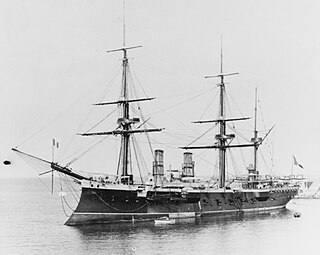
Sfax was a protected cruiser built for the French Navy in the 1880s. She was the first vessel of the type to be built for the French Navy, which was a development from earlier unprotected cruisers like Milan. Unlike the earlier vessels, Sfax carried an armor deck that covered her propulsion machinery and ammunition magazines. Intended to be used as a commerce raider in the event of war with Great Britain, Sfax was rigged as a barque to supplement her engines on long voyages abroad. She was armed with a main battery of six 164 mm (6.5 in) guns and a variety of lighter weapons.

Forbin was a protected cruiser, the lead ship of the Forbin class, built in the late 1880s for the French Navy. The class was built as part of a construction program intended to provide scouts for the main battle fleet. They were based on the earlier unprotected cruiser Milan, with the addition of an armor deck to improve their usefulness in battle. They had a high top speed for the time, at around 20 knots, and they carried a main battery of four 138 mm (5.4 in) guns.
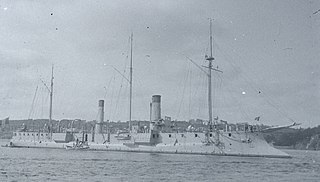
Surcouf was the second Forbin-class protected cruiser built for the French Navy in the late 1880s and early 1890s. The Forbin-class cruisers were built as part of a construction program intended to provide scouts for the main battle fleet. They were based on the earlier unprotected cruiser Milan, with the addition of an armor deck to improve their usefulness in battle. They had a high top speed for the time, at around 20 knots, and they carried a main battery of four 138 mm (5.4 in) guns.

Coëtlogon was a protected cruiser of the Forbin class built in the late 1880s and early 1890s for the French Navy; she was the last member of her class to be built. The Forbin-class cruisers were built as part of a construction program intended to provide scouts for the main battle fleet. They were based on the earlier unprotected cruiser Milan, with the addition of an armor deck to improve their usefulness in battle. They had a high top speed for the time, at around 20 knots, and they carried a main battery of four 138 mm (5.4 in) guns.
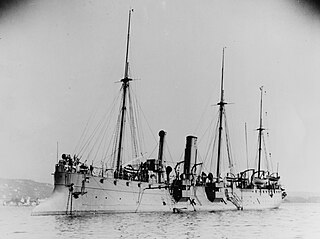
Lalande was a protected cruiser of the Troude class built for the French Navy in the late 1880s and early 1890s. The class was built as part of a construction program intended to provide scouts for the main battle fleet. They were based on the preceding Forbin class, the primary improvement being the addition of armor to the conning tower. Lalande was built in the 1880s and was completed in late 1890. She was armed with a main battery of four 138 mm (5.4 in) guns, protected with an armor deck that was 41 mm (1.6 in) thick, and had a top speed of 20.5 knots.

Isly was a Jean Bart-class protected cruiser built in the late 1880s and early 1890s for the French Navy. The second and final member of the class, Isly and her sister ship were ordered during the tenure of Admiral Théophile Aube as Minister of Marine according to the theories of the Jeune École doctrine. The ships were intended as long-range commerce raiders, and they were armed with a main battery of four 164 mm (6.5 in) guns, were protected by an armor deck that was 50 to 100 mm thick, and were capable of steaming at a top speed of around 19 knots.

Friant was a protected cruiser of the French Navy built in the 1890s, and the lead ship of the Friant class. Friant and her two sister ships were ordered as part of a major construction program directed against France's Italian and German opponents in the Triple Alliance, and they were intended to serve with the main fleet, and overseas in the French colonial empire. They were armed with a main battery of six 164 mm (6.5 in) guns and had a top speed of 18.7 knots.
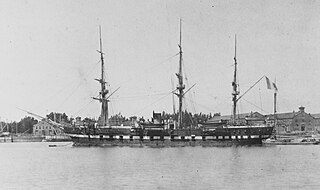
Dubordieu was an unprotected cruiser built for the French Navy in the early 1880s. Intended to serve as a long-range commerce raider, the ship was fitted with a sailing rig to supplement its steam engine on long voyages, and she carried an armament of four 165 mm (6.5 in) and twelve 140 mm (5.5 in) guns. She was among the final French unprotected cruisers, thereafter being replaced by more durable protected cruisers. The French Navy was not satisfied with the vessel, owing to her obsolescent design, since she too weak to defeat the more powerful protected cruisers and was too slow to escape from them.
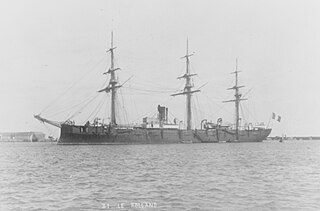
Roland was an unprotected cruiser of the Villars class built for the French Navy in the 1870s, the fourth and final member of the class. The ships were designed for service in the French colonial empire, and they carried a relatively heavy battery of fifteen 138.6 mm (5.46 in) guns, and could steam at a speed of 14.5 knots. The ship was laid down in 1877 and she was completed in 1884. She was deployed to East Asia during the Sino-French War in January 1885, but the conflict had ended by the time she arrived. After completing her tour in East Asian waters, she served a stint in the North Atlantic Squadron from 1890, a role she filled for much of the decade, between periods out of service in reserve. Roland was ultimately struck from the naval register in 1897 and sold for scrap the following year.

Duguay-Trouin was an unprotected cruiser built for the French Navy in the 1870s, the only member of her class. She was ordered as part of a naval construction program after the Franco-Prussian War, and was intended to counter enemy commerce raiders; as such she had a high top speed of 15.5 knots, a heavy armament of five 194 mm (7.6 in) guns, and long cruising radius. Her design was based on the Duquesne-class cruisers, albeit reduced in size, and unlike the earlier vessels, she proved to be a reliable vessel in service.





















